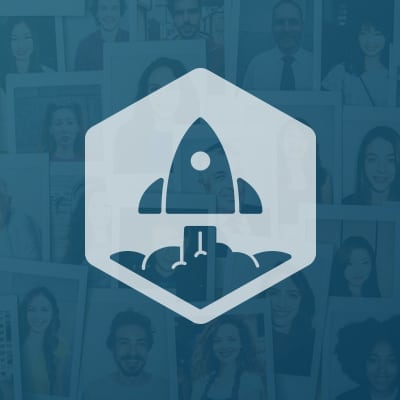We all know Trello and Atlassian, two superstars in the SaaS world. Shortly after Atlassian bought Trello for a cool $450 million, Jason Lemkin gets the story from Michael Pryor, co-founder of Trello, on its beginnings, the obstacles the company overcame, and why the two companies are so well-suited to each other.
One of the most, if not the most, interesting learning from this talk for SaaStr followers is Michael’s explanation of Trello’s “secret sauce” for success. Spoiler: it isn’t just one or two things (when is it ever?) And make sure to watch the whole to talk to get Jason’s reason for why you should never sell your company at $20 million in ARR.
And if you haven’t heard: SaaStr Annual will be back in 2018, bigger and better than ever! Join 10,000 fellow founders, investors and execs for 3 days of unparalleled networking and epic learnings from SaaS legends like Jyoti Bansal, Aaron Levie, Josh James, and Dustin Moskovitz. If you don’t have tickets, lock in Early Bird pricing today and bring your team from just $549! (Prices go up July 1st.) Get tickets here.
TRANSCRIPT
Jason Lemkin: Let’s welcome Michael Pryor to the stage. Very cool.
[applause]
Jason: Thanks for coming.
Michael Pryor: Thanks for having me.
Jason: This is fun. We’ll start and end The Annual with some founder’s founders and some good stories. I actually want to talk almost nothing about the acquisition, other than giving it some context around the story.
I wanted to start with this fun slide. This is me. Here is planning different parts of the The SaaStr Annual on Trello. Who here does not use Trello? Can we have a show of who does not use Trello?
There are a few, and we’ll talk about that. What I want to actually have a little fun as a founder’s founder story is, it seemed a lot of us, we read “TechCrunch,” or whatever form we get in…Wow, Trello’s acquired for $450 million, that came out of nowhere. It’s a pretty long story getting there, isn’t it? 17 years?
Michael: Yeah.
Jason: [laughs]
Michael: A lot of failures along the way.
Jason: A lot of failures. I want to highlight one thing and I want to hear the story. Trello comes out of Fog Creek which is a suite of products. One of which is FogBugz. I logged apparently 18,688 FogBugz in the system.
That was my first experience to the family of products. It saved my life. I’ve actually done a number of investments, QA related out of that experience. You guys started Fog Creek in 2000?
Michael: Yeah, it was in New York City.
Jason: Was it the good or bad part of 2000? [laughs]
Michael: It was still good then.
Jason: Still good?
Michael: Yeah, it was still good.
Jason: It seemed like everyone could start a .com and just become a billionaire overnight?
Michael: Yeah, we started doing consulting. We thought and we’d build software on the side and sell the software with the proceeds that we were getting from consulting. At that time, there were no software companies in New York City.
Jason: Nothing, you had no peers?
Michael: Yeah, you could work for an ad agency or a bank, but there was no pure software play going on. We didn’t want to move to Silicon Valley. We just, naively, started a company there.
Jason: Did you have any mentors, local mentors or anything?
Michael: No.
Jason: No? [laughs]
Michael: My co-founder, Joel Spolsky, he had worked at Microsoft for a couple of years. He had a lot of experience, worked on Excel. He had a lot of ideas about how to run a company and how to run it well. He started blogging about that. It took off. Joel and Software became a big hit. People ask about the secrets…
Jason: Early, early content marketing?
Michael: Yeah. Like, “How do I do that?” It’s like, “Well, go back to 2000 when no one is blogging and start a blog then.” It’s not great advice.
[laughter]
Michael: We started back then and didn’t have an idea for a product. It wasn’t, “Hey, let’s start this company. We’re going to build this product.” It was more about let’s make a cool place for developers to work in New York City, because you couldn’t do that as a developer.
You were in the back office at some bank or something like that. Just started building things. In fact, the first thing that we ever built was a content management system called CityDesk that became a complete failure because it was a desktop version of content management instead of a SaaS. It was movable type and type pad at that time.
We’re figuring out that people couldn’t get shell access to their Web servers to upload the CGI scripts. They solved that problem. We tried to solve it in this other way and that was one of the first examples of big failure.
Jason: Total failure.
Michael: We made a little bit of money off of it. With FogBugz, it was just something that we had on the side. We said, “Hey, put it up on the website, sell it. We’ll see what we do.”
Jason: That story keeps working with Slack and Yammer, the side projects that just take off. It was your own tool. You put it up. Did you have a sense back then of how big the next generation developer market would be, or anything? Did you have any idea? Did you know you were in a big market? Did it feel small?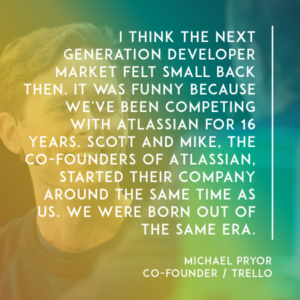
Michael: No, I think it felt small. I think like it was funny because we’ve been competing with Atlassian for 16 years basically. Scott and Mike, the co founders of Atlassian, started their company basically around the same time. We were born out of the same era.
Jason: It was the same.
Michael: We competed pretty hard in the marketplace for a very long period of time. We still compete. We still sell FogBugz or Fog Creek still sells FogBugz. I’m now an Atlassian employee. I don’t think if you went back to me and asked me then that I would have thought you could build a $6 billion company out of that.
Jason: You wouldn’t have thought?
Michael: Yeah.
Jason: I want to come back to Trello, but one question out of that. I had not really thought through that you and Atlassian were born in that era. Trello happened quickly, but the relationships go back 17 years?
Michael: Yeah.
Jason: This was not a random call you get from Atlassian wanting to buy the company?
Michael: We weren’t like close friends but I knew them. We introduced each other at conferences and things like that. I knew a lot about their company obviously because I would pay very close attention to what was going on. There were a lot of similarities.
That was really if you dig down and figure out why I thought this was such a great idea to put these companies together it was because the people and the ideas behind it just matched so well.
Jason: Atlassian and Fog Creek, and then we’ll talk about Trello as a company, partial not total competitors, but partial competitors. The learning from that, founders struggle with how to deal with competition and competitors. Do you build those relationships? Does it not matter? We overreact and underreact to competition in different ways.
Michael: I’m going to confess a little bit. First of all, I want to thank you for doing this because this is amazing, what you built. I was here last year sitting in the audience and Jay Simons was here on the stage.
Jason: He was. He was great.
Michael: When he came up, my VP of Sales clapped and I gave her a look. I was like…
[laughter]
Michael: It’s funny, because as people…As we’ve gone through this acquisition and integration, all these things, the people inside the company are just amazing people. You probably know that on the outside, but it’s hard when you’re competing directly with somebody to really become friends.
Jason: It can be hard.
Michael: Yeah.
Jason: It can be hard. Even in a touchy, feely developer haven, the competition is still pretty visceral, huh? [laughs]
Michael: Yeah.
Jason: Let’s go back in time. Trello is a side project too at the time, or what’s the story of the birth of Trello?
Michael: Because we started the company as just a place for developers to work, like a great place for developers, we had a culture of, “Hey, let’s just try different things.”
We would do what we called creek weeks. It’s like Google’s 20 percent time, except we would take time out and just try new things, like, “Let’s build a new product.”
Jason: That actually works?
Michael: Yeah, we had a bunch of things. One summer, we took a bunch of interns and built a screen sharing tool called Co Pilot. That was before LogMeIn and GoToMyPC existed. That was actually serving a real need at that time. We didn’t see it. We marketed it to customer service people instead of the way that LogMeIn and GoToMyPC marketed more to consumers.
I think that was the right product, right time, but wrong marketing strategy. That was another example of failure in some sense. We made decent money off of it, but it never became as… those other companies IPOed and became giant successes. We had this pattern of, “Hey, let’s take some time off, build new things.” Trello was born out of that.
Jason: It seemed like Trello got acquired in 90 seconds. I was looking back on my SaaStr post on Trello. I think it was 2012, launched in 2011, right?
Michael: Yeah.
Jason: Let’s go back. People actually struggle to answer this question, but what was the secret sauce for Trello? What made it take off? You built a dozen or more products over the years, right?
Michael: Yeah.
Jason: They didn’t all take off. You have a more information here than most. What made it click?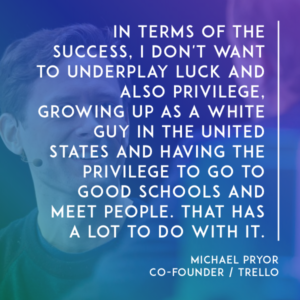
Michael: The secret to success. I don’t want to underplay luck. It’s a big factor in that, and also privilege, the ability from the history of growing up as a white guy in the United States and having the privilege to go to good schools, and meet people, and like those things. That has a lot to do with it, I think.
There’s also things about the product that we learned from historically mistakes that we had made in the past. At that time, we were looking at the way…We saw our own developers who were using FogBugz. They’re putting sticky notes up on the wall in their office to manage what they were working on.
We’re scratching our head going, “Why are they doing that? They could just put this stuff in FogBugz.” They didn’t because they were looking for a much more lighter way of getting perspective on what they were working on, a higher level, than that detail, very low level. We started thinking about that. Joel came up with this idea.
He said, “OK, what if we built a to do list. It’ll just have five slots in it.” Everyone has one list. You have a list. I have a list. Everyone in the company has one list. There’s only five slots. Two things that you’re working on now, because with developers, you could be compiling so you need something else you have to work on.
Two things you’re going to work on next and one thing you’re never going to do. If you come and ask me to do this thing, you can see it’s on my to do list, I’m never going to do it. He said, “Everyone will just publish those to do lists, and then you’ll be able to see what people are working on.”
That idea, he wanted to call it Five Things or Five Camels. I don’t know where that camels from. I don’t know where that came from. FogBugz is not the best name for a product. I don’t know.
Jason: The Z thing always threw me, but I rolled with it. It’s a good product.
Michael: I have a fun Trello naming story actually. We tried to figure out that name. We couldn’t come up with a name. We were going to launch at TechCrunch Disrupt. We had a deadline. We were like, “We need a domain name.” We got the whole company together and we all voted on names. People were throwing out names and…
Jason: Five Camels was fairly far down the list?
Michael: Yeah, that was very low. What we came up with was, at the time, we had a mascot that was a manatee and Trello was doing planning. The name that they came up with was Planatee.
[laughter]
Jason: Planatee from FogBugz and Fog Creek?
Michael: Yeah. I even have a sweatshirt, just a little a manatee logo and Trello. I just put my head in my hands, and then I’m like, “I can’t do this.” Joel said, “Well, you got till 5:00 o’clock, because I don’t know. We have to go on stage tomorrow. We just have to do this.”
I went back to my desk and went to one of those instant domain search websites and just was typing in. I tried everything. I could not come up with a name.
Jason: I didn’t know that still worked in 2011.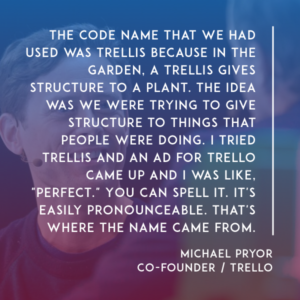
Michael: [laughs] Yeah, the code name that we had used was trellis because in the garden, a trellis gives structure to a plant. The idea was we were trying to give structure to things that people were doing. I tried trellis and an ad for Trello came up. I was like, “Perfect.”
You can spell it. It’s easily pronounceable. That’s where the name came from. It was almost Planatee. That close.
[laughter]
Jason: That would have been like 320, I think, maybe 285 is my guess.
Michael: The runner up was CardVark.
Jason: CardVark?
Michael: Just like a card and an aardvark.
[laughter]
Jason: How many marketers worked at the company at the time, 12, 20?
[laughter]
Jason: Any product marketers at the company?
Michael: It’s funny because I think…
Jason: Brand marketers?
Michael: …Joel was such a great writer. His website was so good at attracting the audience, which a lot of our later things used that audience to bootstrap like Stack Overflow, bringing the developer community together. We never really developed a traditional marketing muscle, which I think Atlassian did. They were very good at marketing.
Jason: They were very good at it, very good.
Michael: It was almost like a crutch for us. Joel’s website let us get ahead, but it meant that we never really developed it.
Jason: If you have the leads, you can be crummier down the funnel, or something like that.
I almost get it, but what was the secret sauce? The five [inaudible 12:45] I get. You’ve got the super easy user interface. You’ve got this. I think Trello was somewhat innovative in moving cards and in Kanban style, but it might not be the first time the raw elements were used.
There are some secret sauce that got it. I used in 2012. I was probably a fifth generation viral user. Someone shared a project they were building on Trello and I’m like, “This is better than what I’m using.” I became a convert. What got it to go critical?
Michael: I think that, one, the audience that we had built it for was not developers. It was everyone else. All the marketers, sales people, people using it to plan their weddings, or the gift giving for their kid at Christmas, the in laws getting together just to make sure they don’t buy the same gifts. Things like that.
The idea was we’re not going to add dependencies, and milestones, and all these project management terms. That’s not what we were building. We were building something for everyone else. The idea was this is going to be a visual tool.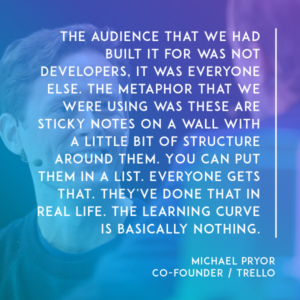
The metaphor that we were using was these are just sticky notes on a wall with a little bit of structure around them. You can put them in a list. Everyone gets that. They’ve done that in real life.
Jason: They get it.
Michael: The learning curve is basically nothing. The metaphor of how the app works, you get it already if you’ve ever written something on a sticky note and put it on a wall.
I think knowing the market that we were going after or at least the market we were not going after as well as that visual metaphor…You said the word Kanban. It was like, “We are never going to use that word.” The market that we were going after would never know what that would be.
Jason: They would not know.
Michael: Part of the success is, I don’t want to overuse the word simplicity, but I think that the simpleness of the metaphor that people already understand. Instead of, for example, you come into Salesforce, you have to learn what a contact is.
Then you have to learn what a lead is, and opportunity and how those things…You have to understand the grammar of Salesforce in order to become effective.
Jason: I’m with you. Can I challenge you on one thing just to learn?
Michael: Sure.
Jason: I’m with you, but I think every product-focused founder that’s passionate about product as we are, believes in consumerization of the enterprise, and ease of use and elegance. There’s a lot of pretty elegant products out there today that launch on Product Hunt every 90 seconds. There’s always more than that.
The sticky, it’s easy to use, but there’s always something and maybe it was cross pollinating from the existing base or somehow Joel’s Bugz conceded, but there’s always a story that makes this more than…We all know to build ease of use software today, don’t we? I think in 2017, we’ve gotten the message.
Michael: That’s like the…
[crosstalk]
Michael: That’s an entry…
[crosstalk]
Jason: It’s become entry, right?
Michael: Yeah. Now it has to be fun, and emotional, and human, and all these other things.
Jason: Yes, a little ML and AI sprinkled in as well.
Michael: Timing is probably an important component to that. If you look, it was probably a year before we launched Trello that the iPhone came out.
You have all these people now that have this device with them all the time that basically the connectedness to other people has increased. That collaboration aspect of, “Hey, I can…” You see that explosion in the communication sector with Slack and even consumer communication like WhatsApp and all those things.
I also think that we took advantage of that in the collaboration sector and the idea that people are just doing…Projects, they wouldn’t call it project management when you’re working on your house or doing a renovation to your house, but you needed a tool to solve that problem.
Jason: How much is mobile usage, web percent as mobile?
Michael: 30 to 40.
Jason: 30 to 40?
Michael: It’s not solely mobile. That’s overlap.
Jason: That’s why in enterprise, it’s a nuanced issue, because it’s really not one paradigm. It’s 30 to 40 percent, is the answer.
Michael: When we look at people that use Trello, 90 percent use it for work. 50 percent use it for home, things that they do in their personal life. There’s a 40 percent overlap there. Almost everyone is using it for work. A huge percentage is using it for their personal life.
Jason: Let’s go back a little bit. You mentioned Jay from Atlassian. Atlassian is famous for being bootstrapped. Fog Creek was bootstrapped, right?
Michael: Yes.
Jason: Just because I think it’d be interesting to folks here, how did you guys make the real decision to spin it out? You had to run it and you ended up raising money. You became a traditional venture backed company after being bootstrapped for half your life. [laughs]
Michael: Trello, we actually bootstrapped Trello within Fog Creek.
Jason: Internally?
Michael: Yeah, for three years. Launched in 2011, but we didn’t spin it out until 2014.
Jason: What’s the decision? You made a decision to go for it in a certain way.
Michael: We were having success. There were four different things that we wanted to do product wise. We looked at our dev team and we were like, “OK, we’re going to have to do one. Then we finish that, we’ll do the next. Then we finish that, then we’ll do the next,” as far as resources. We were using the profits from Fog Creek to invest into…
Jason: That’s the tension a lot of people have, especially if you go from services to software. How big was Fog Creek at the time, employees?
Michael: Probably around 50 people.
Jason: 50?
Michael: Yeah.
Jason: That’s a lot of resources going to…
Michael: 20 were working on Trello.
Jason: That explains, it’s 40 percent of the company.
Michael: We used to do profit sharing at Fog Creek every year. We’d take the excess profit from the company and give it back to the employees. When we were doing Trello, we didn’t because we were investing back.
Jason: Every employee is paying for it?
Michael: No, they got equity. It turns out, that worked out in the end.
[laughter]
Michael: That was nice. That was hard at that point and time because they were like, “Hey, where is my big bonus?” We were like, “Well, we’re investing in this thing that we hope will be something…”
[crosstalk]
Jason: That is hard.
Michael: That was a shift in the way that we were thinking about it. Basically, we needed to do those four things. We were like, “We should just be doing them all at the same time.” We just can’t because we don’t have the money to hire the developers.
We knew investors from the people that invested in Stack Overflow. We just went…
Jason: I forgot Stack Overflow was spun out too.
Michael: We just talked to them. Two of them, Spark and Index were like, “We’re in.”
Jason: That’s easy. It’s a five minute decision.
Michael: I took five minutes and term sheet, done.
Jason: No, I got that.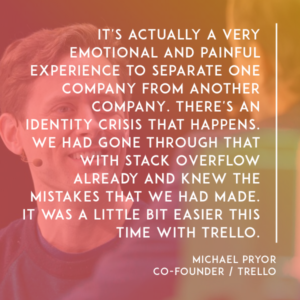
Michael: We had gone through the pain of…It’s actually a very emotional and painful experience to separate one company from another company. There’s an identity crisis that happens. We had gone through that with Stack Overflow already and knew the mistakes that we had made. It was a little bit easier this time with Trello.
Jason: When did you have nothing to do with Fog Creek at all, not one bit to do with it?
Michael: Probably, Friday.
Jason: Friday?
[laughter]
Jason: Because also when you do that, you’ve gotta draw a deep line, right?
Michael: Yeah.
Jason: It’s especially tough with founders. If you keep one leg in the services business and one leg in the SaaS business, it’s tough.
Michael: At Fog Creek, we hired Anil Dash, who’s a well known person in the tech industry, to be the CEO of Fog Creek probably about six months ago.
Jason: Yeah, recently.
Michael: It’s in good hands. They’re working on cool new things. I’m excited about that.
Jason: Let’s talk a little bit about, it’s SaaStr, and business models, and learnings on freemium. In some ways it’s still early. Even notwithstanding the big exit. What are your big takeaways from freemium? You’ve got a product that both businesses and gardeners are using, and people are using the plan birthday parties, different monetization strategies.
How does that work in general? How does it impact how you’ve learned about sales and marketing? How is that different than selling a cool developer tool?
Michael: When we launched Trello, we got up… We were actually in a competition at TechCrunch. It was startup battlefield or something like that. Joel got up on stage and he said, “We’re going to build this product. We’re going to get 100 million people to use it. One percent of them will pay us for $100 a year.”
Jason: Classic freemium app.
Michael: No, $100 million, right?
Jason: Yeah.
Michael: At the time, that was just ridiculous nonsense. Like, “100 million people?” [laughs] I think we’ve just passed 20 million signups. It’s like, “OK, we’re on that path.”
Jason: You can see the 100 million now. Now you realize the conversion is not as simple as you initially thought, right?
Michael: Right. I think the idea was give away a lot of value. You used it to plan this conference, right?
Jason: Yeah, and our speakers and stuff?
Michael: Did you pay for it?
Jason: What’s that?
Michael: Do you pay for Trello?
Jason: I pay for so much stuff, I don’t know. Honest, there’s a high probability I don’t pay. I may have still…what’s the gate?
Michael: Well, I think that’s the…
[crosstalk]
Jason: I don’t even know what the gate is, right?
Michael: There isn’t really much of a gate. In fact, when we built Trello, we didn’t even think about monetization for a couple of years until Google shut down Google Reader, I think, at some point. Everyone started to panic about free services.
They were like, “I’m not going to use a free service because you’re just going to shut it down.” We were like, “Oh, we have to start charging people in order to reduce friction for a signup? OK.”
Jason: It does work that way actually, doesn’t it?
Michael: I think balancing that is definitely a tricky thing. Obviously, tomorrow, we could say, “Hey, if you make more than 10 boards, you have to pay us.” We would make more money. That would destroy what Trello is.
There’s a delicate balance between giving people that are heavy users of the product, giving them more features and more value and letting them see the value that they get, and then they’re totally willing to pay for it. That’s a process.
Jason: Yeah, and so related to that the 100 million one percent model, you’re at 20 million. All the users aren’t the same value. How do you identify, and especially when you don’t have a gate, how do you identify the ones that are of the…How do you staff against it? Now you’ve got to service these customers differently, or maybe you don’t?
Michael: An interesting takeaway from this is I think that when we look at companies that use Trello, there’ll be a larger company who will have hundreds of thousands of Trello users within the company and yet those are a whole bunch of different pockets of Trello teams. They don’t know each other.
That’s the bottoms up where the employees are able to start using Trello because it doesn’t cost them anything. We find that when you go into those organizations and you say, “Hey, did you know you had 6,000 people using Trello inside your company?” They’re not on SSO. You don’t know who is going where and…
[crosstalk]
Jason: The early Dropbox strategy.
Michael: You’re just talking to the IT person. For security reasons and those kinds of things, those deals are fairly easy.
Jason: That’s a key part of sales today, is that…
Michael: It’s basically, you’re not selling. They’ve already adopted your product. The trick is, can you get them to pay for what they are already using?
Jason: In 2017, that strategy going to the CIO and saying there’s 600 people or whoever it is, do you have to be careful how you do it? You can do it with a stick or a carrot. Sometimes, they can be seen as a security risk even in 2017.
Well, my data is flowing outside of my organization in an uncontrolled fashion. Have you learned the yin and yang or trade off there yet or is it you’re not sure yet?
Michael: If you’ve already have the adoption across the whole company and you have a ton of people using it, it’s fairly easy to demonstrate why the things that you’re selling on the enterprise version makes sense for the company.
That’s only one piece of how we sell Trello.
Jason: No, but it’s a proven model that works. It’s a proven model that works.
Michael: For us, it’s fairly easy because our product is so horizontal. We’re across sales, marketing, finance, legal. If you’re selling a more vertical product, it’s a little bit trickier. Now, you’re in a slice of the company and you’re probably going to need more per user than you would normally if you were a horizontal product.
Jason: I want to jump back on a topic I want to make sure we have time on just because I think it’s interesting when you talked about mobile. Mobile is 30 to 40 percent of your usage. A lot of folks in SaaS struggle to staff different teams, struggle to do platform, struggle, especially old people like you and me that have been doing software longer than since 2014, and we have desktop roots.
We go back and we grew up in a browser area. We hired an iOS developer. With that 30, 40 percent, how do you staff it? How do you deal with the tradeoffs in product and engineering?
Michael: We have a dedicated iOS team and a dedicated Android team. From the very beginning, the mobile strategy was always very important to us. As I mentioned, the iPhone coming out, people connected, and this consumerization of collaboration that we were trying to tackle.
It’s also important, when you’re building a product that’s so horizontal and you really want to reach everyone in the world, that’s our market. It’s not just the US. You start to think about places like Brazil, or India, or China where people maybe the way that they work and live is not sitting in front of a computer all day, but they have these smartphones.
You start thinking about, “OK, well, connectivity and…” That is a hugely important piece of our mission which is to be an international product and also an international company. We have people that are working remotely for us. 60 percent of the people that work for Trello are working all over the world, people in Peru, in Hawaii, in Austria, in Canada.
Jason: I should know. How localized is Trello?
Michael: 21 languages.
Jason: 21 languages. This is another learning. A lot of us, we localize late. We have a lot of technical debt there.
[crosstalk]
Michael: Well, we did too and it’s…
[crosstalk]
Jason: What were the learnings there?
Michael: We tried different things around crowdsourcing or getting, paying for translations.
Jason: They’re pretty low quality, isn’t it?
Michael: Yeah, you could do a little bit of both. I think the trick that we learned was, if you internationalize, if you translate your app into another language, that doesn’t mean it’s localized. There’s jokes in the app when you’re using it that have to be translated. The people that translate it might not understand what those are, but also just marketing it.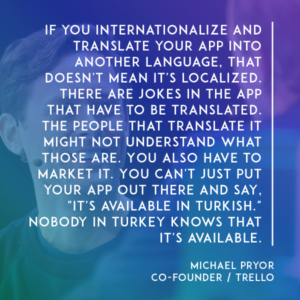
You can’t just put your app out there and be like, “It’s available in Turkish.” Nobody in Turkey knows that it’s available. How do you solve that problem? We actually did some AB test where…Well, AB.
We translated into Spanish and didn’t do anything in Spain. We translated it into French and did marketing. I went to conferences and spoke. Don’t translate your app and then do no marketing for that. That’s a mistake.
Jason: That’s because we think that the Internet is so global. You do Spanish in Spain, even with the brand, nothing? It doesn’t take off? You need those super seeders or something in Trello to spread it. The plan is to get on jet.
Michael: You could wait, but it’s going to take a very long time.
Jason: Literally, getting on a jet and take off.
Michael: That makes a huge difference. Just marketing, trying to get it. You’re thinking about what’s the PR strategy in this country? Who are the incubators that we want to go talk to? All those different things. You have to do that work. You can’t just be like, “Here’s my app. It’s available in your language.”
Jason: Just last question on that, and then I want to hit one other thing before we run out of time. When did you make the decision to localize, because I think we all do it late? It’s probably pretty early in revenue, but when did you make the decision and did you do it earlier?
Michael: No, it was probably a year and a half ago.
Jason: A year and a half ago?
Michael: Yeah. It was pretty late. It’s a big effort. Basically, we had to take everyone across the company and shift focus to do this and get it done. There’s that upfront work of doing, not just translating all those strings, but changing the way your product functions to understand. You got the website, the billing, all those different things.
Jason: One last question. We’ve got just one more minute. I don’t want to talk about too much about M&A because this stuff is much more fun. What’s the big takeaway? When do you know when to sell or not to sell? For a founder, what’s the answer?
Michael: I’ll tell you, you made a tweet, I think I’ve paraphrased it. It said, “If you get to 20 million in ARR, never sell.”
Jason: Yes.
Michael: Something like that?
Jason: Something like that.
Michael: I always wanted to ask you…I looked at that tweet, OK. [laughs] I spend a lot of time looking at that tweet trying to…
[laughter]
Jason: What’s the post behind the tweet?
Michael: I’ll give you one…We spend a lot of time, Mike, Scott, and I focused on the culture, and the people, and the mission. It turns out that we were having one of these conversations where we were like, “We’re trying to get to 100 million.” Mike’s like, “That’s our goal internally, just to get to 100 million people using our products.”
I was like, “Um.” There were just a lot of similarities between the companies and the focus on the product. We had a lot of matchup. I think that’s one of the reasons why I did it. Also, we spun off from Fog Creek, 16 year old company, the cap table is this long.
Jason: I get all that.
Michael: Everyone gets paid. We go down the cap table.
Jason: Do you know in your gut?
Michael: Yeah, definitely a right decision. I want to ask you, why did you say that? What made you tweet that out?
Jason: I think that…it was funny. It was the topic of the conversation I had with Lew Cirne here last year, from New Relic.
He sold Wiley to CA for like 400 million. In some ways, founded New Relic to do it again. He sold the CA now to Atlassian, kind of like [laughs] polar opposite ends. I think at 20 million, if you have happy customers, if your NPS is high, it really is unstoppable.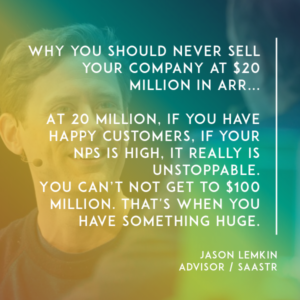
You can’t not get to $100 million. If you have $20 million and you have a 50 NPS, even if you’re horrible at sales and you’re horrible at marketing, like that $20 million, worst case, it turns into 30 million next year. You’ve been doing this for 17 years. That 20 million will get to 100.
Now, your ARR multiple for exit may never be better [laughs] than at a certain moment, including IPO. IPOs aren’t even that great of a multiple. They’re not that great. From a journey perspective, if you get to 20, you can get to 100. That’s when you have something huge. That’s my zen learning. It’s impossible to get to one, and it happens.
Twenty is this moment where holy crap, I can finally see that 100. That’s the learning. Congratulations. It’s great.
Michael: Thank you so much.
Jason: Thanks for all the time and coming out. It’s great.

